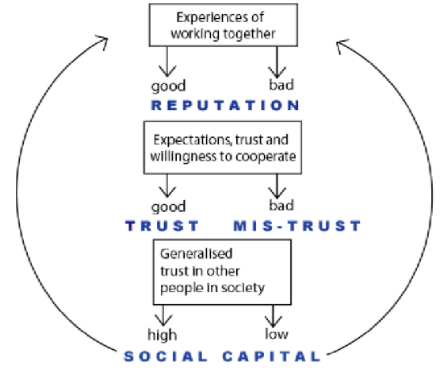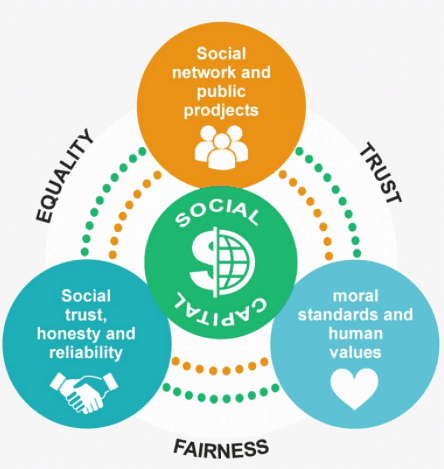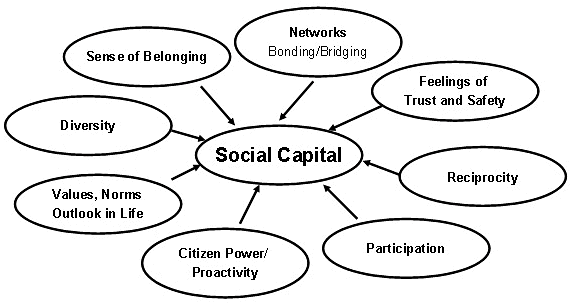Population as Social Capital | Geography Optional for UPSC PDF Download
Social Capital
Social capital refers to the value derived from social networks and connections, which can improve an individual's or group's productivity, similar to the contributions of physical and human capital. The concept of social capital was initially discussed by L.J. Hanifan in 1916 and later developed by Pierre Bourdieu, who identified it as resources linked to networks of relationships. James Coleman further defined social capital as a neutral resource that consists of aspects of social structure, facilitating actions within that structure.
Social capital, as popularized by Robert Putnam, is a crucial component for building and maintaining democracy. Putnam identified two primary components: bonding social capital, which involves connections within a group, and bridging social capital, which connects groups with different backgrounds. The OECD defines social capital as networks combined with shared norms, values, and understandings that facilitate cooperation within or among groups.
Social capital can be classified into three main categories:
- Bonds: connections based on a common identity, such as family, close friends, or people of the same culture or ethnicity.
- Bridges: connections that extend beyond a shared identity, such as distant friends, colleagues, or associates.
- Linkages: connections to people or groups at different social levels, either higher or lower on the social ladder.
In summary, social capital encompasses the value and resources derived from social networks and relationships, playing a significant role in the productivity and success of individuals and groups. It includes bonds, bridges, and linkages, which connect people within and across different social groups, contributing to the overall social structure and facilitating actions within it.

Determinants of social capital
- Social capital is a crucial component of both formal and informal relationships within a community. Key determinants of social capital include networks, trust, reciprocity, and shared social norms. These elements help individuals within a community communicate, cooperate, and make sense of their collective experiences more easily.
- Trust plays a significant role in reducing social and business transaction costs, as it enables smoother interactions and fosters a sense of reliability among community members. Additionally, tolerance of diverse beliefs and cultures is facilitated by shared norms that promote acceptance, respect, and understanding.
- Reciprocity, the practice of exchanging things with others for mutual benefit, encourages individuals to strike a balance between their self-interest and the greater good of the community. Furthermore, education acts as an essential enabler, empowering individuals to become more aware and rational in their thoughts and actions.
In summary, social capital is influenced by various determinants, including networks, trust, reciprocity, and shared social norms. These factors contribute to a cohesive community where members can communicate and cooperate effectively, embrace diversity, and achieve a balance between personal interests and the collective good. Education plays a crucial role in enabling individuals to think and act rationally within this framework.

Negative social capital
- Social capital can have negative and unproductive consequences as well. Tightly knit communities, such as certain immigrant groups, often have strong social bonds where individuals heavily rely on their relatives or people of the same ethnicity for support. However, their lack of connections with the broader society can cause them to remain perpetual outsiders, which may impede their economic advancement. It is important to note that social exclusion can occur in both directions: tight-knit groups may isolate themselves, but they may also be excluded by the larger community.
- Moreover, like any other form of capital, social capital can be utilized for purposes that harm others. For example, the connections and trust that enable drug cartels and criminal gangs to function are forms of social capital, albeit ones that are detrimental to the rest of society.
Other form of social capital
- Social capital is another form of natural capital, which can be divided into three main components: natural resources, ecosystem services, and the aesthetics of nature. Natural resources are the materials and energy sources used in production processes. Ecosystem services are essential natural processes, such as the conversion of carbon dioxide into oxygen by trees, which humans rely on. The aesthetics of nature encompass the beauty of various natural elements like rainforests, seashores, birds, and forests.
- On the other hand, produced economic capital refers to harvested or manufactured products, the built environment, constructed physical infrastructures, and financial resources such as money. Cultural and intellectual properties also fall under this category. Human capital pertains to the knowledge, skills, and health of an individual.
- Lastly, social capital is characterized by the quality and patterns of relationships within a community. Overall, social capital is an essential aspect of society that complements natural capital and contributes to a more balanced and sustainable world.
How social capital is different?
- Social capital is distinct from other forms of capital, such as human, produced, and natural capital, in several ways. Firstly, it is a relational concept, meaning it is based on the connections and relationships between individuals and groups, rather than being an attribute or property that can be owned by individuals or businesses.
- Secondly, the creation of social capital is not a straightforward process like that of human or produced economic capital. Instead, it is the outcome of various historical, cultural, and social factors that cultivate norms, values, and social connections, ultimately leading to the formation of networks and associations that enable collective action.
- Lastly, social capital behaves differently in terms of its usage and durability. It can grow stronger when used by reinforcing the underlying networks, norms, and values that support it. Conversely, it can weaken if not utilized or maintained. Building social capital requires consistent, positive efforts, but it can be quickly depleted if not nurtured.
Overall, social capital is a unique concept that emphasizes the importance of relationships, shared values, and collective action in society, setting it apart from other forms of capital.

Population as Social Capital
- The concept of social capital does not always apply to an entire population. When considering a nation as a whole, various factors must be taken into account, including the size of the country, the diversity of its people, demographic characteristics, and the ability of regional groups to unite as one cohesive unit.
- As the size and diversity of a population increase, it becomes more challenging to cultivate a positive social capital. Various communities may have competing interests and priorities, which can create obstacles in achieving social cohesion.
- Differences in demographic factors such as literacy rates, employment structures, dependency ratios, and gender biases can make it difficult for smaller social capital groups to work together towards common goals.
- Even the most basic and traditional segments of a population possess their own forms of social capital, with unique cultural practices and knowledge systems that have served them well throughout history. However, it is crucial to ensure that these groups can coexist with modern developments without compromising their values.
- By integrating smaller-scale social capital units, an entire population can be transformed into a larger social capital that works collectively towards sustainable development and the well-being of all its members.
Advantages of population as social capital
- Social capital and health: Studies show that higher levels of social capital and social cohesion lead to improved health conditions. When trust among citizens is high, average mortality rates tend to be lower. Trust, along with formal and informal social networks, allows people to access health education and information, design better healthcare systems, collaborate on infrastructure improvements, and work together to address cultural norms that may negatively impact health.
- Social capital helps prevent crime and violence: Poverty and violence are connected, and the relationship can be positively or negatively influenced by social institutions, such as families and local associations. By fostering shared values and norms, community violence can be reduced or maintained at lower levels. Informal relationships among neighbors enable them to look out for one another and maintain a safer environment, helping to alleviate the stress caused by poverty and unemployment.
- Social capital and education: The educational achievements of a population directly impact economic development. Financial support alone cannot increase education levels; involvement from families, communities, and the state is necessary to enhance the relevance and quality of education.
- Social capital and environment: Social capital is crucial in rural areas because it impacts residents' abilities to organize for development. It enables groups to come together to address their common concerns with the state and private sector.
- Social capital and water use and sanitation: Social capital promotes information sharing about sanitation and contributes to the construction of community infrastructure. Collaboration between the state and civil society can improve infrastructure design and maintenance by securing financial resources and ensuring projects meet community needs.
- Social capital and economic development: There is growing evidence that trust, civic norms, and other social capital factors are essential for economic development. Social capital influences various aspects such as trade and migration, economic reform, regional integration, new technologies, and security.
- Social capital and trust can enhance economic transactions by providing parties with more information, enabling them to coordinate activities for mutual benefit, and reducing opportunistic behavior through repeated transactions. Social capital plays a significant role in shaping the outcomes of economic actions at both micro and macro levels.
Threat to Social Capital
- In established democracies, an increasing number of citizens are questioning the effectiveness of public institutions just as liberal democracy becomes more widespread globally. In the United States, for example, this democratic disarray might be related to a broad and ongoing decline in civic engagement that began about 25 years ago. This decline in social capital may also be occurring in other advanced democracies.
- However, the traditional foundation of social capital is shifting and evolving, and its future will be influenced by new factors. One such factor could be changes in family structures, as traditional avenues for civic involvement may not be well-suited for single or childless individuals.
- Another factor contributing to the decline in social capital is suburban sprawl, which has disrupted the spatial integrity of communities. People now have to travel greater distances for work, shopping, and leisure activities, leaving them with less time and inclination to participate in groups and social capital-building activities.
- Lastly, electronic entertainment, particularly television, has significantly privatized leisure time. The hours spent watching TV directly detract from involvement in group activities and the development of social capital. Thus, these factors together may be contributing to a decline in social capital in advanced democracies.
Conclusion
In conclusion, social capital is a valuable aspect of society that focuses on the relationships, shared values, and collective actions of individuals and groups. While it has numerous benefits, such as improved health, reduced crime, and economic development, it can also have negative consequences if not properly nurtured. Various determinants, including networks, trust, reciprocity, and shared social norms, contribute to the development of social capital. However, challenges such as shifting family structures, suburban sprawl, and electronic entertainment pose threats to the future of social capital in advanced democracies. Therefore, it is crucial to recognize and address these challenges to foster social capital and create a more cohesive and sustainable society.Frequently Asked Questions (FAQs) of Population as Social Capital
What is the main difference between bonding and bridging social capital?
Bonding social capital refers to connections within a group, such as family, close friends, or people of the same culture or ethnicity. Bridging social capital, on the other hand, connects groups with different backgrounds, such as distant friends, colleagues, or associates.
Why is trust an essential determinant of social capital?
Trust plays a significant role in reducing social and business transaction costs, as it enables smoother interactions and fosters a sense of reliability among community members. Trust also encourages cooperation and collaboration, which can lead to increased productivity and success.
How can social capital have negative consequences?
Social capital can have negative consequences when tightly knit communities isolate themselves from the broader society, leading to social exclusion and impeding their economic advancement. Additionally, social capital can be utilized for harmful purposes, such as in the case of criminal gangs or drug cartels.
What are some advantages of having a strong social capital within a population?
Strong social capital within a population can lead to improved health conditions, reduced crime and violence, better educational outcomes, increased economic development, and more effective management of natural resources and infrastructure projects.
What factors may contribute to the decline of social capital in advanced democracies?
Factors contributing to the decline of social capital in advanced democracies may include changes in family structures, suburban sprawl disrupting the spatial integrity of communities, and the privatization of leisure time due to electronic entertainment, particularly television.
|
304 videos|717 docs|259 tests
|
FAQs on Population as Social Capital - Geography Optional for UPSC
| 1. What is social capital? |  |
| 2. How does population contribute to social capital? |  |
| 3. What are the benefits of social capital? |  |
| 4. How can social capital be measured? |  |
| 5. Can social capital be developed and strengthened? |  |





















